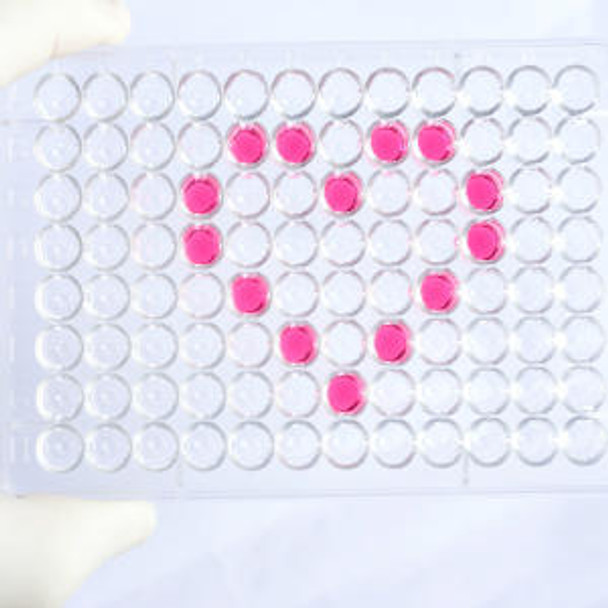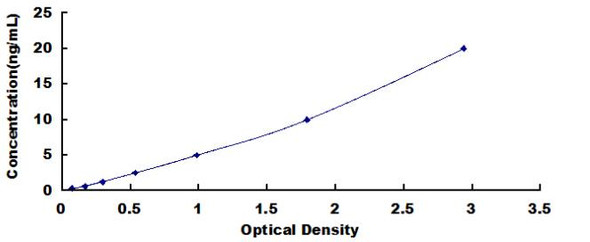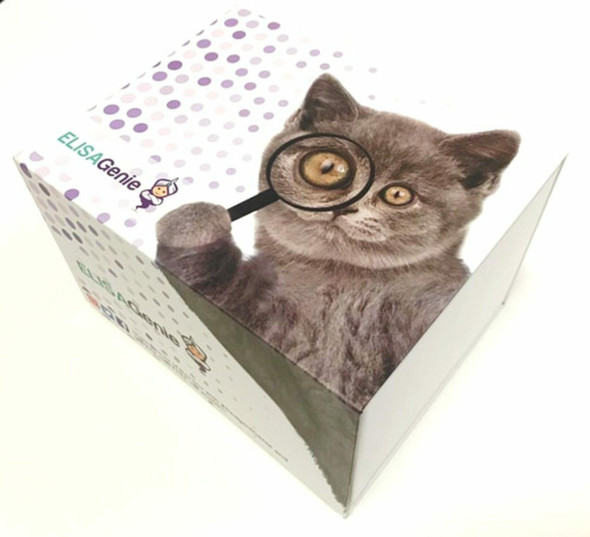Human Estrogen-related receptor gamma (ESRRG) ELISA Kit (HUEB0552)
- SKU:
- HUEB0552
- Product Type:
- ELISA Kit
- Size:
- 96 Assays
- Uniprot:
- P62508
- Range:
- 0.312-20 ng/mL
- ELISA Type:
- Sandwich
- Synonyms:
- ESRRG, Estrogen-related receptor gamma, ERR3, NR3B3, ERR gamma-2, ERRG2, ERRgamma, Estrogen receptor-related protein 3, NR3B3, Nuclear receptor subfamily 3 group B member 3, KIAA0832
- Reactivity:
- Human
Description
Human Estrogen-related receptor gamma (ESRRG) ELISA Kit
The Human Estrogen Related Receptor Gamma (ESRRG) ELISA Kit is a sophisticated and accurate tool designed for the precise measurement of ESRRG levels in human samples such as serum, plasma, and cell culture supernatants. This kit offers outstanding sensitivity and specificity, ensuring trustworthy and consistent results for a variety of research applications.ESRRG is a key transcription factor involved in regulating numerous biological processes, including metabolism and energy homeostasis. Its dysregulation has been linked to various diseases such as metabolic disorders, cancer, and neurodegenerative conditions, highlighting its importance as a biomarker for disease diagnosis and therapeutic development.
By utilizing the Human ESRRG ELISA Kit, researchers can delve deeper into the molecular mechanisms involving ESRRG and gain valuable insights into its role in health and disease. This kit provides a valuable tool for advancing research in the field of genetics, molecular biology, and personalized medicine. Elevate your research with the precision and reliability of the Human ESRRG ELISA Kit from Assay Genie.
| Product Name: | Human Estrogen-related receptor gamma (ESRRG) ELISA Kit |
| SKU: | HUEB0552 |
| Size: | 96T |
| Target: | Human Estrogen-related receptor gamma (ESRRG) |
| Synonyms: | ERR gamma-2, Estrogen receptor-related protein 3, Nuclear receptor subfamily 3 group B member 3, ERR3, ERRG2, KIAA0832, NR3B3 |
| Assay Type: | Sandwich |
| Detection Method: | ELISA |
| Reactivity: | Human |
| Detection Range: | 0.312-20ng/mL |
| Sensitivity: | 0.12ng/mL |
| Intra CV: | 5.3% | ||||||||||||||||||||
| Inter CV: | 9.5% | ||||||||||||||||||||
| Linearity: |
| ||||||||||||||||||||
| Recovery: |
| ||||||||||||||||||||
| Function: | Orphan receptor that acts as transcription activator in the absence of bound ligand. Binds specifically to an estrogen response element and activates reporter genes controlled by estrogen response elements (By similarity). Induces the expression of PERM1 in the skeletal muscle. |
| Uniprot: | P62508 |
| Sample Type: | Serum, plasma, tissue homogenates, cell culture supernates and other biological fluids |
| Specificity: | Natural and recombinant human Estrogen-related receptor gamma |
| Sub Unit: | Homodimer. Binds TLE1, PNRC1 and PNRC2. Binds GRIP1 (By similarity). Interacts with NRIP1, NCOA1 and NCOR2. |
| Research Area: | Epigenetics |
| Subcellular Location: | Nucleus |
| Storage: | Please see kit components below for exact storage details |
| Note: | For research use only |
| UniProt Protein Function: | ERR3: Orphan receptor that acts as transcription activator in the absence of bound ligand. Binds specifically to an estrogen response element and activates reporter genes controlled by estrogen response elements. Belongs to the nuclear hormone receptor family. NR3 subfamily. 3 isoforms of the human protein are produced by alternative splicing. |
| UniProt Protein Details: | Protein type:DNA-binding; Transcription factor; Nuclear receptor Chromosomal Location of Human Ortholog: 1q41 Cellular Component: nucleoplasm Molecular Function:AF-2 domain binding; protein binding Biological Process: positive regulation of transcription, DNA-dependent; regulation of transcription, DNA-dependent; transcription initiation from RNA polymerase II promoter |
| NCBI Summary: | This gene encodes a member of the estrogen receptor-related receptor (ESRR) family, which belongs to the nuclear hormone receptor superfamily. All members of the ESRR family share an almost identical DNA binding domain, which is composed of two C4-type zinc finger motifs. The ESRR members are orphan nuclear receptors; they bind to the estrogen response element and steroidogenic factor 1 response element, and activate genes controlled by both response elements in the absence of any ligands. The ESRR family is closely related to the estrogen receptor (ER) family. They share target genes, co-regulators and promoters, and by targeting the same set of genes, the ESRRs seem to interfere with the ER-mediated estrogen response in various ways. It has been reported that the family member encoded by this gene functions as a transcriptional activator of DNA cytosine-5-methyltransferases 1 (Dnmt1) expression by direct binding to its response elements in the DNMT1 promoters, modulates cell proliferation and estrogen signaling in breast cancer, and negatively regulates bone morphogenetic protein 2-induced osteoblast differentiation and bone formation. Multiple alternatively spliced transcript variants have been identified, which mainly differ at the 5' end and some of which encode protein isoforms differing in the N-terminal region. [provided by RefSeq, Aug 2011] |
| UniProt Code: | P62508 |
| NCBI GenInfo Identifier: | 50402102 |
| NCBI Gene ID: | 2104 |
| NCBI Accession: | P62508.1 |
| UniProt Secondary Accession: | P62508,O75454, O96021, Q68DA0, Q6P274, Q6PK28, Q6TS38 A8K4I0, A8K6I2, B3KY84, E9PGB7, F8W8J3, |
| UniProt Related Accession: | P62508 |
| Molecular Weight: | 52,462 Da |
| NCBI Full Name: | Estrogen-related receptor gamma |
| NCBI Synonym Full Names: | estrogen related receptor gamma |
| NCBI Official Symbol: | ESRRG |
| NCBI Official Synonym Symbols: | ERR3; NR3B3; ERRgamma |
| NCBI Protein Information: | estrogen-related receptor gamma |
| UniProt Protein Name: | Estrogen-related receptor gamma |
| UniProt Synonym Protein Names: | ERR gamma-2; Estrogen receptor-related protein 3; Nuclear receptor subfamily 3 group B member 3 |
| Protein Family: | Estrogen-related receptor |
| UniProt Gene Name: | ESRRG |
| UniProt Entry Name: | ERR3_HUMAN |
| Component | Quantity (96 Assays) | Storage |
| ELISA Microplate (Dismountable) | 8×12 strips | -20°C |
| Lyophilized Standard | 2 | -20°C |
| Sample Diluent | 20ml | -20°C |
| Assay Diluent A | 10mL | -20°C |
| Assay Diluent B | 10mL | -20°C |
| Detection Reagent A | 120µL | -20°C |
| Detection Reagent B | 120µL | -20°C |
| Wash Buffer | 30mL | 4°C |
| Substrate | 10mL | 4°C |
| Stop Solution | 10mL | 4°C |
| Plate Sealer | 5 | - |
Other materials and equipment required:
- Microplate reader with 450 nm wavelength filter
- Multichannel Pipette, Pipette, microcentrifuge tubes and disposable pipette tips
- Incubator
- Deionized or distilled water
- Absorbent paper
- Buffer resevoir
*Note: The below protocol is a sample protocol. Protocols are specific to each batch/lot. For the correct instructions please follow the protocol included in your kit.
Allow all reagents to reach room temperature (Please do not dissolve the reagents at 37°C directly). All the reagents should be mixed thoroughly by gently swirling before pipetting. Avoid foaming. Keep appropriate numbers of strips for 1 experiment and remove extra strips from microtiter plate. Removed strips should be resealed and stored at -20°C until the kits expiry date. Prepare all reagents, working standards and samples as directed in the previous sections. Please predict the concentration before assaying. If values for these are not within the range of the standard curve, users must determine the optimal sample dilutions for their experiments. We recommend running all samples in duplicate.
| Step | |
| 1. | Add Sample: Add 100µL of Standard, Blank, or Sample per well. The blank well is added with Sample diluent. Solutions are added to the bottom of micro ELISA plate well, avoid inside wall touching and foaming as possible. Mix it gently. Cover the plate with sealer we provided. Incubate for 120 minutes at 37°C. |
| 2. | Remove the liquid from each well, don't wash. Add 100µL of Detection Reagent A working solution to each well. Cover with the Plate sealer. Gently tap the plate to ensure thorough mixing. Incubate for 1 hour at 37°C. Note: if Detection Reagent A appears cloudy warm to room temperature until solution is uniform. |
| 3. | Aspirate each well and wash, repeating the process three times. Wash by filling each well with Wash Buffer (approximately 400µL) (a squirt bottle, multi-channel pipette,manifold dispenser or automated washer are needed). Complete removal of liquid at each step is essential. After the last wash, completely remove remaining Wash Buffer by aspirating or decanting. Invert the plate and pat it against thick clean absorbent paper. |
| 4. | Add 100µL of Detection Reagent B working solution to each well. Cover with the Plate sealer. Incubate for 60 minutes at 37°C. |
| 5. | Repeat the wash process for five times as conducted in step 3. |
| 6. | Add 90µL of Substrate Solution to each well. Cover with a new Plate sealer and incubate for 10-20 minutes at 37°C. Protect the plate from light. The reaction time can be shortened or extended according to the actual color change, but this should not exceed more than 30 minutes. When apparent gradient appears in standard wells, user should terminatethe reaction. |
| 7. | Add 50µL of Stop Solution to each well. If color change does not appear uniform, gently tap the plate to ensure thorough mixing. |
| 8. | Determine the optical density (OD value) of each well at once, using a micro-plate reader set to 450 nm. User should open the micro-plate reader in advance, preheat the instrument, and set the testing parameters. |
| 9. | After experiment, store all reagents according to the specified storage temperature respectively until their expiry. |
When carrying out an ELISA assay it is important to prepare your samples in order to achieve the best possible results. Below we have a list of procedures for the preparation of samples for different sample types.
| Sample Type | Protocol |
| Serum | If using serum separator tubes, allow samples to clot for 30 minutes at room temperature. Centrifuge for 10 minutes at 1,000x g. Collect the serum fraction and assay promptly or aliquot and store the samples at -80°C. Avoid multiple freeze-thaw cycles. If serum separator tubes are not being used, allow samples to clot overnight at 2-8°C. Centrifuge for 10 minutes at 1,000x g. Remove serum and assay promptly or aliquot and store the samples at -80°C. Avoid multiple freeze-thaw cycles. |
| Plasma | Collect plasma using EDTA or heparin as an anticoagulant. Centrifuge samples at 4°C for 15 mins at 1000 × g within 30 mins of collection. Collect the plasma fraction and assay promptly or aliquot and store the samples at -80°C. Avoid multiple freeze-thaw cycles. Note: Over haemolysed samples are not suitable for use with this kit. |
| Urine & Cerebrospinal Fluid | Collect the urine (mid-stream) in a sterile container, centrifuge for 20 mins at 2000-3000 rpm. Remove supernatant and assay immediately. If any precipitation is detected, repeat the centrifugation step. A similar protocol can be used for cerebrospinal fluid. |
| Cell culture supernatant | Collect the cell culture media by pipette, followed by centrifugation at 4°C for 20 mins at 1500 rpm. Collect the clear supernatant and assay immediately. |
| Cell lysates | Solubilize cells in lysis buffer and allow to sit on ice for 30 minutes. Centrifuge tubes at 14,000 x g for 5 minutes to remove insoluble material. Aliquot the supernatant into a new tube and discard the remaining whole cell extract. Quantify total protein concentration using a total protein assay. Assay immediately or aliquot and store at ≤ -20 °C. |
| Tissue homogenates | The preparation of tissue homogenates will vary depending upon tissue type. Rinse tissue with 1X PBS to remove excess blood & homogenize in 20ml of 1X PBS (including protease inhibitors) and store overnight at ≤ -20°C. Two freeze-thaw cycles are required to break the cell membranes. To further disrupt the cell membranes you can sonicate the samples. Centrifuge homogenates for 5 mins at 5000xg. Remove the supernatant and assay immediately or aliquot and store at -20°C or -80°C. |
| Tissue lysates | Rinse tissue with PBS, cut into 1-2 mm pieces, and homogenize with a tissue homogenizer in PBS. Add an equal volume of RIPA buffer containing protease inhibitors and lyse tissues at room temperature for 30 minutes with gentle agitation. Centrifuge to remove debris. Quantify total protein concentration using a total protein assay. Assay immediately or aliquot and store at ≤ -20 °C. |
| Breast Milk | Collect milk samples and centrifuge at 10,000 x g for 60 min at 4°C. Aliquot the supernatant and assay. For long term use, store samples at -80°C. Minimize freeze/thaw cycles. |










